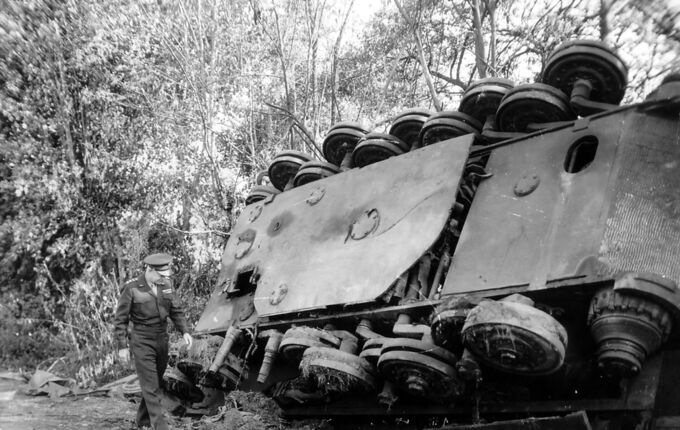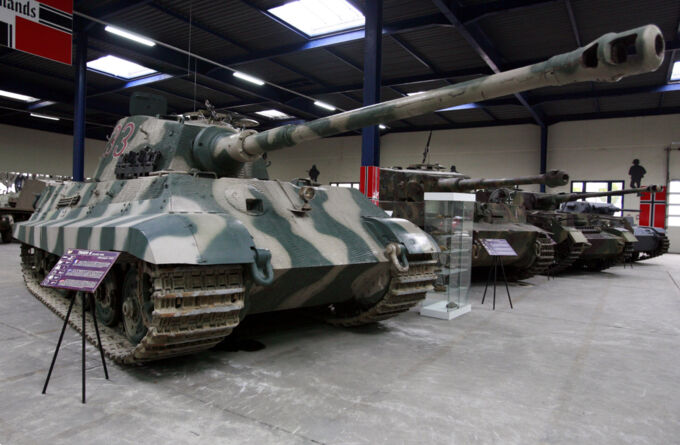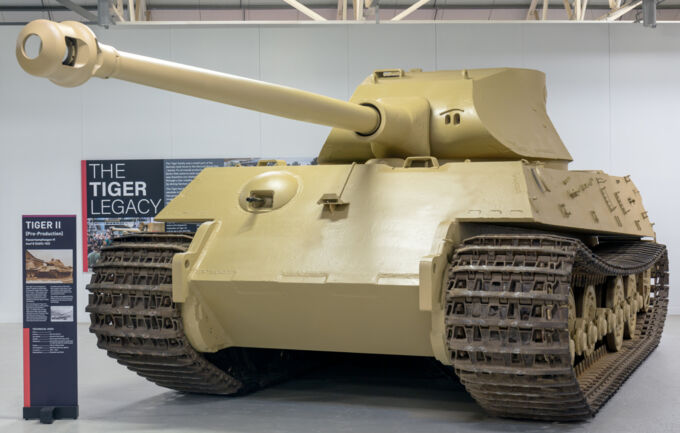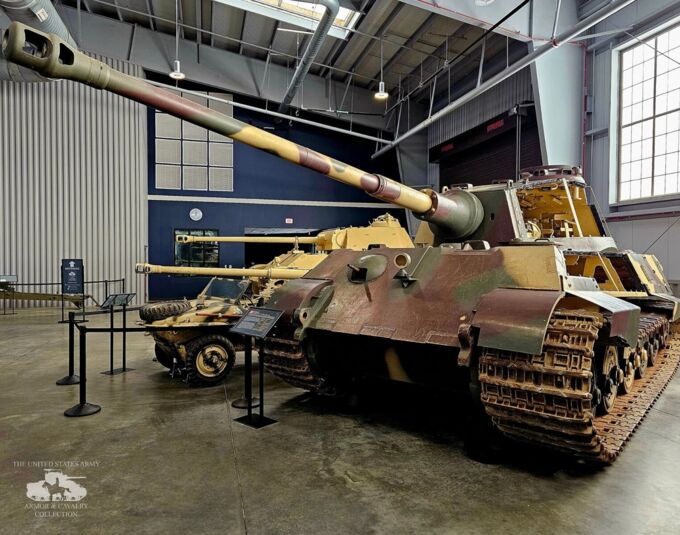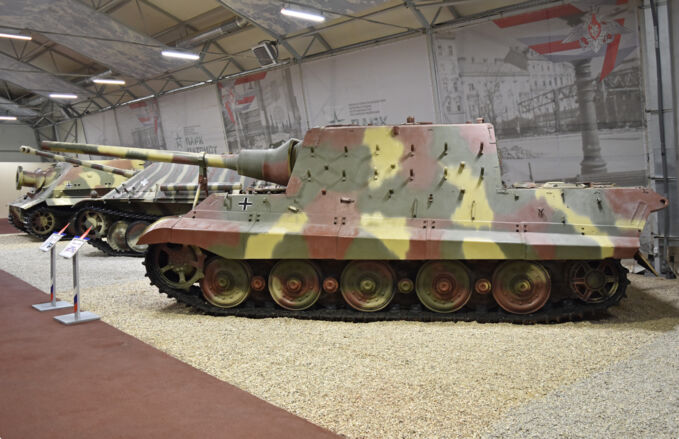The Tiger II or Sdkfz. 182 (Sdkfz. 267 / Sdkfz. 268 for Command vehicles), also known as the King Tiger (officially Panzerkampfwagen Tiger Ausf. H/B, P), was delivered to the German Wehrmacht starting in October 1943 and represented one of the most advanced tank designs of World War II. A total of 492 units were produced, with the majority manufactured by Henschel and Krupp. The Tiger II combined the robust armor of its predecessor, the Tiger I, with sloped frontal armor up to 185 mm thick and the powerful 8.8-cm KwK 43 L/71 gun, capable of destroying almost any Allied tank at long range. Weighing 70 tons, with a top speed of 38 km/h (road) and a range of up to 170 km, it was prone to mechanical failures and fuel shortages, limiting its strategic effectiveness.
Development
As early as 1942, it was clear that German tanks such as the Pz IV, Pz III, and the heavy Tiger I were inferior to Allied models such as the Soviet T-34 and IS-2 and the American Sherman Firefly in some crucial areas, particularly in terms of mobility and sloped armour. These tanks could not only be produced in large numbers, but also had tactical advantages.
The development of the Tiger II was driven by the Henschel and Porsche companies. While Porsche’s design was more technically ambitious than the VK.45.01 (P) and VK.45.02 (P), Henschel’s design ultimately prevailed as it was easier to produce. Mass production began in 1944 and a total of 492 vehicles were produced by the end of the war. This comparatively low production figure stood in stark contrast to the tens of thousands of tanks produced by the Allies and highlighted the difficulties involved in producing such a complex vehicle.
The Tiger II was armed with an 8.8 cm KwK 43 L/71, a powerful long-barreled gun capable of destroying enemy tanks at ranges of up to 2,000 meters. Its frontal armor was exceptionally thick at up to 185 millimeters and, combined with sloped armor, offered excellent protection from enemy fire; however, tanks such as the IS-2, SU-100, SU-122, and SU-152 were very dangerous to a Tiger II because of their large calibers they could easily destroy the frontal armor if they fired first or if they were not yet destroyed, although the 8.8 cm KwK 43 L/71 could also penetrate their armor with ease. However, the tank was limited in many ways due to its enormous weight of 70 tons. The 700 hp Maybach HL230 P30 engine struggled to power the tank efficiently, which proved particularly problematic in difficult terrain. The top speed of 38 km/h on the road dropped drastically to around 10–15 km/h off-road, and the limited range of around 120 kilometers on the road was further limited by high fuel consumption.
The Tiger II was not only intended to be a response to the enemy’s technological advances, but also to have a psychological impact. With its impressive size and aggressive design, it was intended to inspire fear and respect. However, despite its superior firepower and armor, the tank was often viewed as a strategic blunder. Its enormous complexity led to mechanical problems, and the logistical demands were almost impossible to manage given Germany’s limited resources towards the end of the war. The production of a single Tiger II was extremely time-consuming and expensive. One vehicle cost around 800,000 Reichsmarks, comparable to the cost of 8 Pz IV H / 16 T-34-85 / 8 M4 Shermans / 10 StuG III or 3 Churchill Mk VII — funds that could have been used to produce other types of tank.
Variants
VK.45.02 (P)
The VK 45.02 (P) was a project developed by Ferdinand Porsche during World War II for the Tiger II heavy tank. Unlike its predecessor, the VK 45.01 (P) (Tiger P), no hull was manufactured or tested. The VK 45.02 (P) adopted some features of the Tiger P such as the chassis which was based on the Tiger P design. The engine of the VK 45.02 (P) was a further development of the engine used in the Tiger P. Another feature is the position of the turret which was moved far to the rear in complete contrast to the Tiger P which had its turret quite far forward. However, even though this plan was not implemented, the project gained importance because the turret intended for this tank with the 8.8 cm KwK 43 L/71 was nevertheless manufactured and used on the first fifty PZ VI Tiger II tanks and is known as the Tiger II P.
Tiger II P
The Tiger II P was generally the same model as the Tiger II H, but it is noticeable that the turret of the Tiger II P is more curved than that of the Tiger II H. This was because, as mentioned above, the chassis was built by Henschel and the turrets by Krupp. But where did the Porsche turrets on the Tiger II come from? Krupp received an order from Porsche to build 50 Tiger II turrets according to Porsche’s plans (aka the VK.45.03). Porsche received the order because Ferdinand Porsche, the founder of Porsche, firmly believed he would get this order from the Army Ordnance Office. However, the Army Ordnance Office awarded the order to Henschel and not Porsche. However, the turrets of the Tiger II P had already been built by Krupp. In order not to waste resources, the 50 turrets that had already been built were mounted on the first 50 Tiger II H chassis.
Tiger II H /B
The Tiger II H or B was the series version of the Tiger II and was manufactured by Henschel and Krupp. The difference to the P variant is that the Tiger II H or B had a less curved turret armor than the Tiger II P.
Tiger II 10,5
The Tiger II 10.5 was born out of the idea of installing a powerful 10.5 KwK L/68 in a Henschel turret, which would have had to be enlarged and an additional loader would have been necessary. In the end, this project never left the drawing board.
Jagdtiger
The Jagdtiger was a heavy German tank destroyer in World War II, based on the Tiger II chassis. Weighing 74 tons, it was the heaviest mass-produced armored vehicle of the war. Its main armament was a 12.8 cm PaK 44 L/55, capable of destroying enemy tanks at long ranges. In addition, its frontal armor was up to 200mm thick, making it almost impossible to destroy head-on. Despite its impressive firepower and armor, the Jagdtiger suffered from technical problems such as the vulnerable engine or the maintenance-intensive chassis suspension, which affected its effectiveness on the battlefield.
Famous battles
The Tiger II was deployed on critical fronts throughout the war. From 1944, it fought on both the Eastern and Western Fronts. It posed a significant threat to Allied armor during the Normandy Campaign, although its impact was hampered by Allied air superiority and logistical challenges. It played a crucial role during the Battle of the Bulge (1944/45) and was instrumental in defending key positions in the Battle of Budapest (1945) and the final Battle of Berlin.
Famous Commanders
The most famous Tiger II commanders included Otto Carius, known for his tactical brilliance and numerous tank kills, and Kurt Knispel, who had the most confirmed kills in the entire Second World War. Their skills and leadership cemented their status as legends of the German Panzerwehr.
Otto Carius
Otto Carius was born on 27 May 1922 in Zweibrücken and was a first lieutenant in the Wehrmacht with the Panzerwaffe during World War II. At the beginning of his career, Carius was a loader on a 38 (t). Later, when he was promoted to first lieutenant, he became commander of the famous Tiger I tank, where he even achieved a confirmed aerial kill with his 8.8 cm KwK of the Tiger I. From the beginning of 1945, Otto Carius was commander of a company in the 512th Heavy Tank Destroyer Battalion, where he commanded a Jagdtiger and was deployed on the Western Front. Otto Carius was probably taken prisoner in the Ruhr Pocket by American forces after Operation Plunder; the exact circumstances and time are unknown.
Otto Carius ultimately survived the Second World War and became a pharmacist in Herschweiler-Petersheim in the state of Rhineland-Palatinate, where he founded his own pharmacy and called it the “Tiger Pharmacy” as a reference to the fact that he was a tank ace with the Tiger I. He died on 24 January 2015 in Herschweiler-Pettersheim.
Kurt Knispel
Kurt Knispel was born on 20 September 1921 in Salisfeld. Knispel was drafted on 15 May 1940 and was trained on a Pz I until he was transferred to the 3rd Panzer Regiment 29 of the 12th Panzer Division in November 1940, where he served as a loader and gunner in a Pz IV. In 1942, his unit was equipped with the improved Pz IV F2 and assigned to the 13th Panzer Division.
From April, after a long stay in the hospital, Kurt Knispel became commander of a Tiger I during Operation Citadel in Kursk. A year later, in June 1944, Kurt Knispel became commander of a Tiger II at the time of D-Day. Among other things, he and his unit were to use his Tiger to stop the invasion. He and his unit were the 503rd Heavy Panzer Division. In October 1945, he was transferred to Hungary and was refreshed there, where Kurt Knispel was promoted to sergeant and still commanded a Tiger II.
One day after his promotion to sergeant on April 28, 1945, his Tiger II was involved in combat with several Russian T-34s, where shrapnel from a T-34 shell hit Kurt Knispel in the head and the other soldiers of his Tiger II pushed him into a field hospital where he died two hours later. 28 April 1945 in Urbau (Czechoslovakia). Kurt Knispel was the tank commander with 168 confirmed and 30 unconfirmed kills, the tank commander with the most kills in the entire Second World War.
Surviving examples
Today, several surviving Tiger II tanks are displayed in museums worldwide. A particularly famous example is housed at the Musée des Blindés in Saumur, France, where it has been restored to running condition. The Bovington Tank Museum in the UK also features a well-preserved Tiger II, regularly shown in demonstrations. In Germany, a Tiger II is displayed at the Deutsches Panzermuseum in Munster, while others can be found at the Kubinka Tank Museum in Russia and in the United States at institutions such as the Fort Benning Armor Museum.
Deutsches Panzer Museum
Museum de Blindés
Bovington Tank Museum
Militär Museum Full
U.S. Army Armor and Cavalry Collection
Russia Tank Museum Kubinka
Sources
- [Wiki DE] Panzerkampfwagen VI Tiger II / [Wiki EN] Tiger II
- [Wiki DE] Jagdpanzer VI Jagdtiger
- [Wiki DE] Panzerjäger Tiger P
- [Wiki DE] VK.45.01 (P)
- [Wiki EN] VK.45.02 (P)
- [Wiki DE] Otto Carius / [Wiki EN] Otto Carius
- [Wiki DE] Kurt Knispel
- [Wiki DE] T-34
- [Wiki DE] Sherman Firefly
- [Wiki DE] IS-2
- [WELT] Der Riesige deutsche “Königstiger” war ein Irrweg
- Deutsches Panzer Museum Munster
- Museum De Blindés Saumur
- Bovington Tank Museum
- Militär Museum Full
- Kubinka Tank Museum



